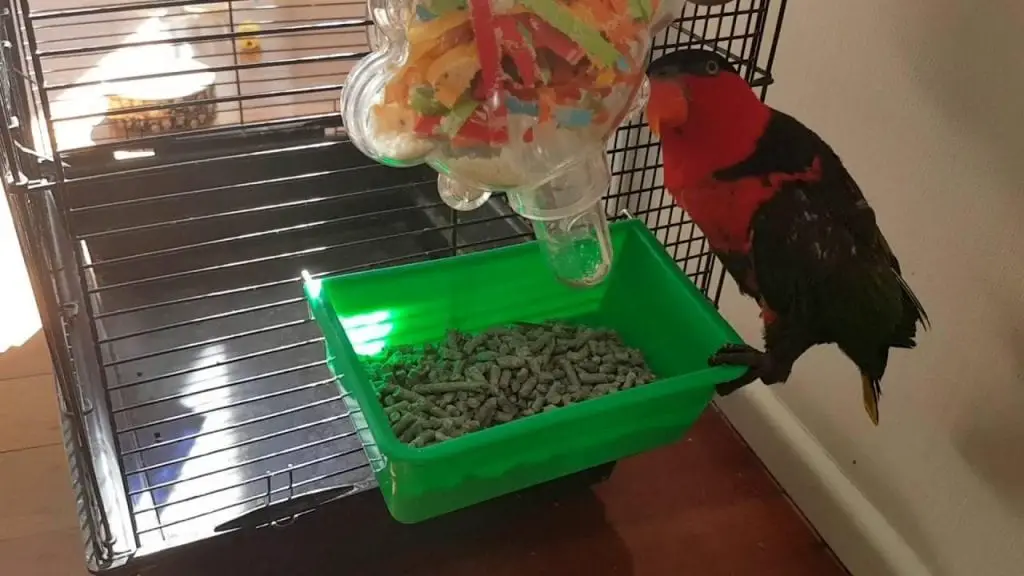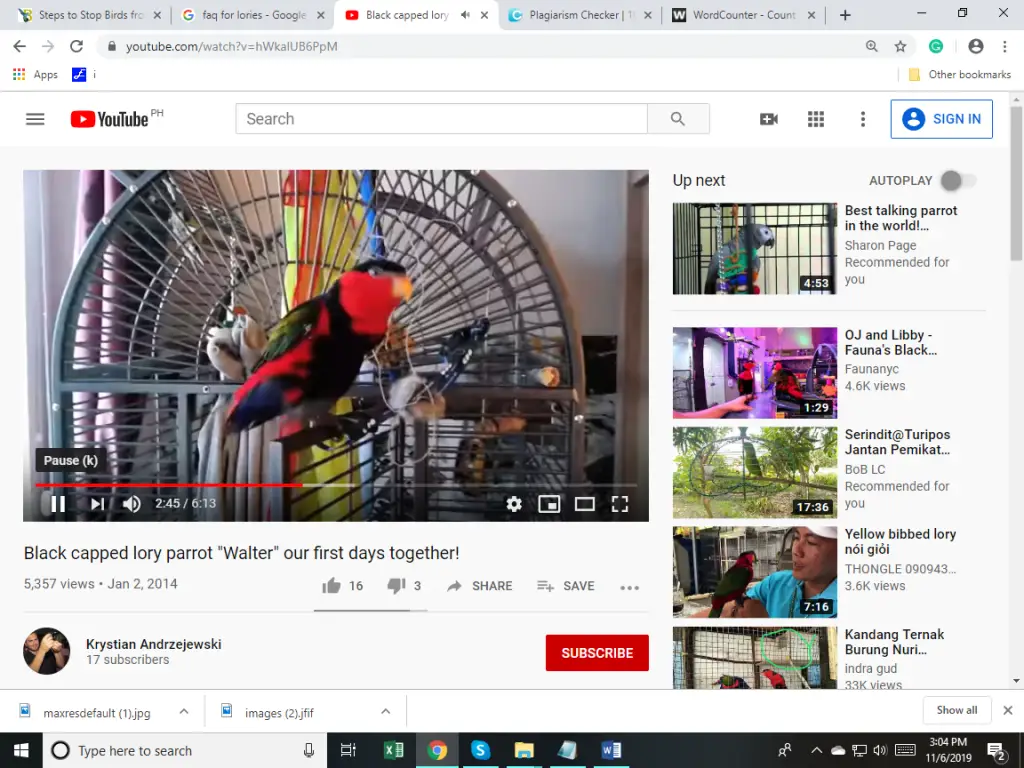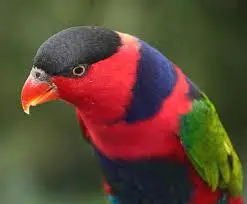Scientific Facts
| Common Name: | Black-capped Lory |
| Scientific Name: | Lorius lory |
| Life Span: | 5 – 25 years |
| Size: | 31 centimeters (12.2 in.) |
| Habitat: | Primary forest and woodlands |
| Country of Origin: | Papua New Guinea |
Overview
The Black-capped Lory is just one of the brush-tongued parrot regarded as the best pet, especially for larger lorries. They display exotic and bold colors, making them popular. This bird is known to be extravagant, playful, intelligent, and animated, too, like other species, but it isn’t as noisy as the others needing some training to prevent them from causing issues.
Indeed, this is a beautiful and rewarding pet for individuals who are well-financed and motivated and willing to give meaningful and significant time and attention to them. Again, although they need more patience, they are excellent pets and talkers and expect them to be affectionate to you. Like other species, they demand high maintenance to sustain their lifestyle.
This unique Black-capped Lory having 7 subspecies come from New Guinea and the nearby islands of Indonesia and Papua New Guinea. As much as possible they don’t like living near humans and prefer living in primary forests or secondary forests which are well-recovered. They are seen in pairs and not in large flocks. In some areas, some are found to be solitary.
Physical Description
The majority of the lories are similar in their physical traits but unique in terms of colorations. This Black-Capped Lory has a medium-sized stocky built, having a short, slightly, and rounded tail. Apart from that, the chest and nape are prominent while the beak is uniquely curved, and there are black stripes that surround the eyes. An adult reaches averagely a length of 31 centimeters or 12 inches and weighs 260 grams. They are larger among the medium-sized. Thus, they need a bigger room.
Black-Capped Lory comes in intricate combinations of colors and fresh tones that are striking. What catches the eye is their bright red and bold color. The black color on top of their heads gives the name to this bird. There are a dark blue belly and bright blue thighs and underneath its tail. Wings are green, and the back and nape come in purplish-blue and dark. These colors leave a beautiful impression on them.
Seven Subspecies of Black-Capped Lory
- L. l. lory: This is found in the West of Papua New Guinea. The nape is blue while the belly and mantle are purple-blue. It has red underwing coverts.
- L. l. erythrothorax: they are in the south whole coast of Papua New Guinea. Their blue nape is like a collar. The blue color comes up to their belly. The wings are yellow and blue mantles are in two bands.
- L. l. somu: These are found in the Southern hill districts in central New Guinea. Nape and mantle are red and blue below the belly.
- L. l. salvadorii: They are on the northwest coast of New Guinea. Underwing coverts are blue-black.
- L. l. viridicrissalis: They are in the Northeast coast in the Western part of New Guinea.
- L. l. jobiensis: They are in Yapen and islands of Mios Num.
- L. l. cyanuchen: They are on Biak island.
Lories as Pets
Lories are so messy when eating. They spoil their cage with their wet and large droppings. Thus, the owner should be diligent in cleaning the cage daily for yeast and bacteria not to grow.
They are so playful and loves listening to music and dancing. They have a strong bond with their owners. They are fed on wet mix and nectar as well.
Native Region or Natural Habitat
These birds come from Papua New Guinea. Most of them are in the Western part and smaller islands nearby. They thrive on the primary forest and the surrounding woodlands. They come in small flocks consisting of 10 birds. They are near their food in rainforest and water sources. When breeding season comes, they are pairs and isolate from the group for nesting and raising young.
Behavior or Temperament
Video URL: https://www.youtube.com/watch?v=VXLzgGxzQpk
The Black-capped Lory is a talented one. Its voice is better than other lory’s average voice. Plus, they mimic various sounds. Owners say they are noisy, while others say they are not. It could be because there is a voice lesson channeling.
Here are the behavior qualities of a Black-Capped Lory:
- These birds are intelligent, and they love to play actively. Therefore, they should be given time to play in the daytime or provide some toys.
- They aren’t into behavioral problems, but they tend to be beaky or possessive, either if they aren’t handled in the proper way.
- On the other hand, they want to be handled and become loyal. They get very affectionate and cuddly if they get well socialized. Thus, they can allot more time playing with their owners.
- Other lories sleep on their back, but black-caped lory does it frequently. They tend to lie on their backs when awake. You can teach them a trick of rolling over or playing dead.
Speech and Sounds
Black-capped lories display a balanced noise level. Natural calls are noisy and loud like a scream, yet it does not happen frequently and not a problem. In contrast, with the right training, they would be talkers. They would mimic sounds and some short and basic phrases. However, they aren’t ideal for owners who live in an apartment.
Housing
To house, a black-capped lory could be a challenge. Lories are known for their sticky, loose, and squirtable droppings that make an odor. Thus, their cage should be set up for easy cleaning. putting acrylic on the side and back part of the cage is recommended.
Here’s a quick guide of a Black-Capped Lory’s housing:
- The cage should be tall for its squirt.
- Hang the cage over a concrete or tile floor, or lay down a plastic sheet on your wooden floor or carpet.
- A minimum size would be 24” w x 24 d x 24” h.
- Give more and spacious rooms. These birds are not as nippy as the others.
- Yet, train them to step up onto your hand or perch. Set up play gym separated from their cage for them not to be too territorial or cage bound. Include toys and chew items as well as nest boxes for sleeping.

Diet
Brushed-tongue parrots are fed on nectar from a flower or flowering trees. You can buy commercialized nectars that are liquid. The diet should consist of half nectar form the diet and half from veggies and fruits. Purees or chopped salad work too.
Like other lories, this bird is prone to gout and iron problem. Thus, they should be fed with food low in protein and iron. Sadly, many green veggies contain high iron. Then, these should be excluded from their diet. these veggies include spinach, turnip tops, and chard. Overfeeding of vitamin C should be stopped for this vitamin stores iron in the body. Peas and beans also contain too much protein.
It is important for owners to know that this bird cannot digest seeds. Small pellets are okay, but liquid nectars are still the best. As a reminder, since you feed your bird with liquid nectar, it is vital that you change the feeding bottles as often as you can so that bacteria will not build up. Washing it frequently is acceptable. Don’t give chocolate, honey, or avocado.
How to Address Your Lory’s Screaming
Screaming is normal for the birds. It cannot be removed totally. They usually vocalize at dawn and dusk. Vocalization is a symptom of being healthy.
Here’s how to address if your lory is screaming:
- Do not give too much attention to their screaming. Don’t talk, look at them, or go to them. Leave the room. Praise your bird when it stops screaming in 5 to 10 counts. Give more time before you attend to them. Do this consistently. All members in the house should do this.
- Teach your lory how to whisper. Teach them whistling or whispering. Use your bird’s intelligence to solve this matter. After some time, your screaming bird will be a pleasant chatterer.
- Give a reward for showing good behavior. Pick one vocalization for your bird. Every time your lory repeats, it gives a reward. Rewards would be toys or food or cuddle them out of their cage.
- Check for patterns of their screaming. Then find ways to prevent the start.
- Teach a redirected activity like foraging.
- Teach it to talk instead of screaming.
Teaching Your Lory to Talk
In order for this thing to happen, your pet must be happy, healthy, intelligent, loves, and trust his owner. The owner then must be patient, caring, and has a lot of time for the bird. The bird then also should follow routines. Young birds learn more quickly than old ones like humans.
Here are the things you need to consider when teaching your lory how to talk:
- Perfect Health: An unhealthy bird will not reach its full potential to talk. Therefore, condition your bird’s health by giving the right food and environment.
- Intelligence: This trait is not true to all birds, but black-capped lory is intelligent, unlike the others. they can mimic sounds and phrases.
- Love and Trust: Lories only talk when trust and love are established between him and his owner. If these two are absent, then the lory will not talk as it has nothing to tell you.
- Care, Patience, and Time. more time and care given leads to faster learning.
- Daily Routine: Routines make birds happy and safe. Lessons should be a part of their schedule. Playing for a short time helps your bird to talk.
- Young Birds: This is from 2 to 5 years old. This stage is the easiest time to learn. This time they learn their parent’s language
Video URL: https://www.youtube.com/watch?v=PiPk8GS8UqM
Lessons
Lesson 1
- Show that they are loved by scratching the bird’s nape.
- As you tickle, say I love you. this is interpreted as an act of love.
- Then, tickle again and say the same sentence again.
- Kiss the beak. Say kiss as you kiss. It is understood that kissing is related to love.
- Next, you can teach his or her name. do it repeatedly with clarity.
- Then, say I love you + the birds’ name.
Lesson 2
Next is the cognitive behavior.
Say good morning in the morning and goodnight at night.
Name also their food, particularly their favorites.
Teach hop up and come for him or her to go to your arm.
Say scratch when you scratch the wing.
Lesson 3
Let them learn by watching and listening. An example is seeing and listening to their owner talk on the phone. This time repetition of words would make them think you are stupid. Integrate jealousy learning. Your pet will select one family member he will bond with. This is another teaching tool.
Availability: Where to Get One?
For potential pet owners of this bird, black-capped lory is for sale on pet stores, especially for birds. If not, you may check online for some sites selling this species.
How to Care

Video URL: https://www.youtube.com/watch?v=hWkaIUB6PpM
- Cage. Choose a big cage for your lory. The bigger it is, the happier your lory is. Include a lot of toys, food and water dishes, perches, and wide space for them. Toys could be bells or ropes so they can climb on it. Chewing items would be bottlebrush, eucalyptus, or acacia. Remember to wash the branches first. Their house should be large, clean, safe, and secure. It should not be durable and has non-toxic materials. It should have perches of different sizes, clean, non-toxic tree branches. It should have water and food at each end. It should not have perches which are so near the food containers. It should be moved outdoors for fresh air and sunlight.
- Diet. They are fed on soft fruits and nectars. They use their tongues to get the nectar. Again, they don’t eat seeds. There are nectar replacements in the market. The dry mix is with dry and plenty of fresh drinking water. The wet mix is wet. Water requirements are reduced. The young ones are fed on a dry and wet mix using different containers or can. Give them supplements along with veggies and fruits. Mix vitamins into the water every 2 to 3 days.
- Before you introduce new birds to the cage, let it stay in another cage, and have it adapt naturally. Give them 2 weeks before introducing them.
- Hygiene. Do cleaning regularly. Take the leftovers and old food. change their water daily.
- ● Deworming. Have your birds wormed in several weeks? Deworming is best done every six months.
- Lice & Mites. Parasites tend to attack birds. Kill them with lice and mite spray. When you spray, spray the bird, perches, and everything inside the cage. Don’t spray the bird’s eyes, of course.
- Training. Handle them in a relaxed and quiet situation. Don’t give stress after taking it home. Spend more time with your bird.
- Breeding. They breed easily and get mature 8 months later. Both sexes look the same.
Keeping Your Lory Safe, Happy and Healthy
Video URL: https://www.youtube.com/watch?v=iWkq42mmTLw
- Provide a lot of attention.
- Give a high quality, fresh and pesticide-free food including veggies and fruits.
- Give clean and freshwater.
- Take and change the water and food containers.
- Give time for misting, bathing, or showering.
- Don’t spray the cage with insecticides.
- Move these things away from your lory since they are very curious and love investigating new things around them. These include hot cooking oil, ceiling fans, leg chains, sandpaper, pesticides, dogs, wood shavings, tobacco, alcohol, and more.
What A Veterinarian Looks for in a Healthy Lory
- Dry and open nares,
- Clear and bright eyes,
- Alert and erect posture,
- Smooth beak,
- Body free from bumps or lumps,
- Smooth and bright feathers,
Common Disorders of Lories
The majority of these diseases are due to malnutrition. Bring your pets to the vet regularly to prevent diseases.
•Hemochromatosis
•Fungal infections
•Liver disease
•Circovirus
•Reproductive disorders
•Parasites
•Obesity
•Injuries
•Bacterial infections
Treating Beak and Feather Disease
Recognizing the Symptoms
1. See for missing feathers on the wings and tail, especially for feathers that fall out so easily. There might be bleeding.
2. Monitor the bird’s flying ability. If your bird is infected, it will not fly well.
3. See you for any discoloration. You should know your bird’s coloration, especially where the yellow feathers are. Check if the tails or feathers have yellow patches.
4. Check of indications of depression. A drop in their vocal activity could mean something.
5. Monitor for secondary symptoms like vomiting, difficulty eating, weight loss, and green mucus.
6. Check for the beak’s fracture or brittleness.
7. Have your bird undergo a test.
Treatment/Prevention
1. Separate the infected birds. Keep enough distance for prevention. Keep them separated for 2 months.
2. Give nutritional supplements. It can somehow suppress the virus. Still, keep them isolated still.
3. Give heat. Feather loss can lower the body temperature of the bird. Get an infrared light. Put it on one side of their cage. It should be 25 to 35 degrees Celsius for 24 hours. Try to put the cage near the window to get Vitamin D.
4. Treat the secondary infections by taking your bird to the vet.
5. If needed, trim the beak by taking your pet to your vet.
Preventing Psittacine Beak and Feather Disease or PBFD
PBFD is caused by a simple virus, infecting and killing the cells of lorries’ feathers and beak. Also, the virus also attacks the immune system.
Here are some tips to avoid PBFD:
- Quarantine the new arrivals for 2 months.
- Disinfect your house. Clean the whole area first. Then apply a concentrate. Let it stay for 10 minutes. Then, rinse well.
- Clean your home from dust. Diseases tend to be transmitted by infected dust. Use air cleaners and vacuums.
- If possible, have your birds vaccinated
FAQ Section
Can Lory birds talk?
Yes, they can. With training, they can learn good vocabulary and talk.
Are lories smart?
Sure. They are known for being smart, especially if they are trained.
How can you tell the age of a lory?
When a lory turns one, it will be a full plumage, and its beak gets bright orange. By 18 to 24 months, they can breed.
Is a lory a type of parrot?
Yes, they are. They are arboreal parrots that have a brush-tipped tongue, which they use to eat nectar.
Do pet birds get lonely?
Many owners think that way, so they get another one for their pets not to be bored or lonely.
Why do birds not freeze to death?
They keep fats in their bodies for winter to help them survive the long and cold nights. These fats will make them warm. They fluff the feathers to get heat.
Do birds have feelings?
Yes, they do.
Can birds fart?
Parrots sometimes make sounds like a fart, but it is really fart. Studies are still done.
How do you know if a bird likes you?
Birds vocalized to show they are happy and content living in your home. They get very vocal as you walk into your room.
Do birds have a memory?
In a study, some birds have a good long term memory.
What does a bird-like to eat?
Various species eat various food. birds mostly eat seeds, fruits, berries, veggies, nectar, and more.
How do birds mate?
Both sexes have a cloaca. The opening gets swell and protrudes. The male sperms are deposited into the cloaca of the female and go up a chamber where it is fertilized.
Do birds get cold?
Like humans, they get cold too. In winter, they depend on their feathers. They fluff their wings to get heat. More fluff, more heat.
Can birds vomit?
Yes. It is normal behavior. Birds do head bobbing and stretching of the neck. Vomiting could be a sign that they ingest something from the cage.
Where do birds go when it hails?
Birds find refuge on trees. Trees give birds shelter when it storms. However, trees can be struck by lightning.
What’s the smartest bird?
Parrots are one of the most intelligent. They have the biggest HVCs.
Why do birds attack me?
It is a natural instinct for birds to protect their own territory, their nest and young from intruders or predators. They swoop to scare intruders, but only a few show aggressive behavior.
Which birds are easy to tame?
Parrots are easily trained and tamed with enough training and time.
Why do birds swoop at you?
They swoop to protect their young, nest, or territory. This is their way of defending themselves.
Do birds feel hot?
Yes, they do. They open their mouth and flutter the muscles in their neck.



